Over the years, I have been avidly collecting all sorts of materials about habits that have been piled up on cozy virtual shelves in Pocket and Workflowy. But a year ago, I finally pushed myself to start a mini-research to test how easy it is to make theory work in practice.
Under the cut you will get acquainted with a squeeze of the results of hundreds of academic articles and books on habit formation, behavioral economics and psychology to develop a framework that not only helps our students to learn English successfully, but is also suitable for developing "sticky" applications and developing good habits in all areas life (the ability to learn is another habit).
With graphs, links to primary sources and the results of the implementation of a really working company. In general, everything as you like.
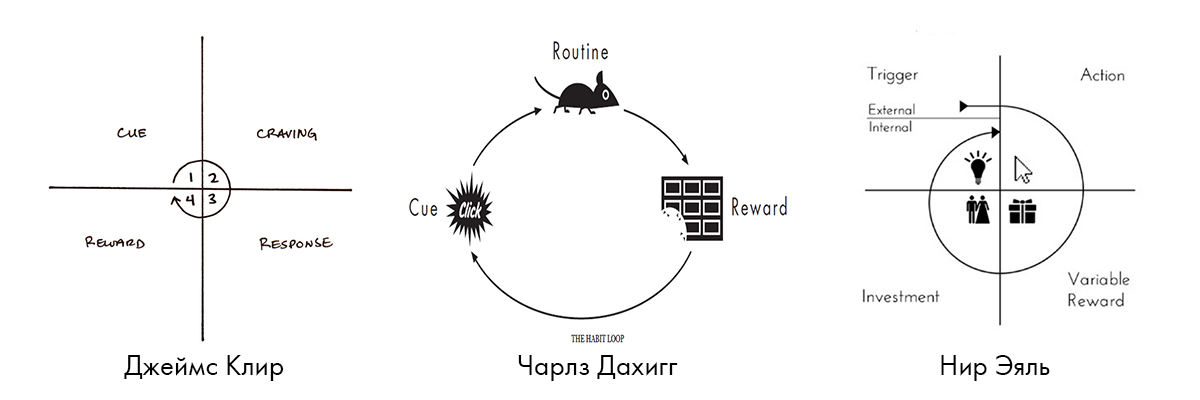
Disclaimer : The article turned out to be VERY voluminous, but in the last paragraph there is a brief summary with key information.
Despite my mediocre ability in mathematics, I managed to enroll in one of the most prestigious lyceums in Ukraine, get a bachelor's degree in statistics, win a Fulbright grant and complete my master's degree in the USA for free , thanks to which I, in turn, entered and successfully dropped out of graduate school in behavioral economics.
The key problem at the academy that caused me to drop out of graduate school is that the receipt of applied research results often stretches for many years (if it even comes to them at all).
Working as a marketer helped me learn not only to theorize, but also actively (and most importantly, FAST) implement all sorts of research results into life, thanks to which I have repeatedly found non-obvious solutions to trivial problems, and even wrote about it on Habré here , here, or, for example, here .
Today, let's talk about a fairly standard task: maximizing user engagement and retention using simple but non-obvious psychological techniques.
Briefly about the problem
For many years we have been developing programs for online English language learning. You can learn more about the approach in this article on Habré , but in short: the key to success in small DAILY classes and a structured approach.
Online classes provide less emotional attachment for most people than offline classes, which makes it much more difficult to achieve ongoing involvement in the educational process. YOU NEED TO HELP USERS TO DEVELOP A HABIT to practice every day .
Result
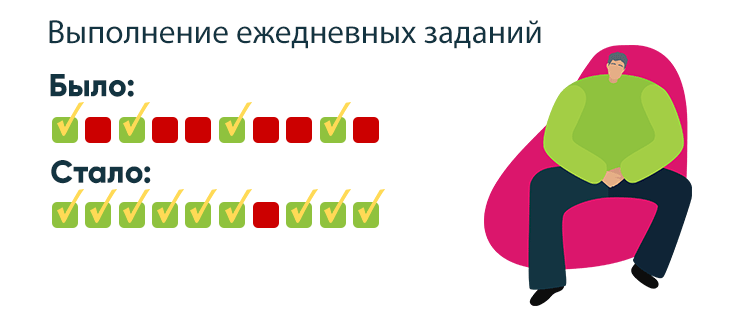
As a result of the implementation of the following approaches, on average, the percentage of completed daily tasks on time increased from 38 to 89%, which significantly reduced the percentage of students who dropped out of the course. 9 out of 10 children successfully complete all 3 months of training (versus 6 out of 10 before the course structure was changed).
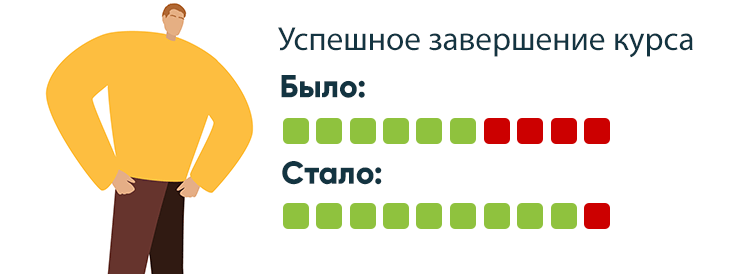
not a LOT of theory about habits
the fact that habits have been actively researched by scientists for many decades, the interest of the general public has appeared relatively recently, thanks in large part to authors like Charles Duhigga (The Power of Habit 2012), Nir Eyala (Hooked: How to Build Habit-Forming Products, 2013) and fellow guys like James Clear (Atomic Habbits, 2019), and BJ Fogg (Tiny Habits, 2020).
First of all, let's pay attention to the key points borrowed by writers from monumental research works, and below we pay more detailed attention to point research.
The Habbit Loop - "loop / loop of habit"
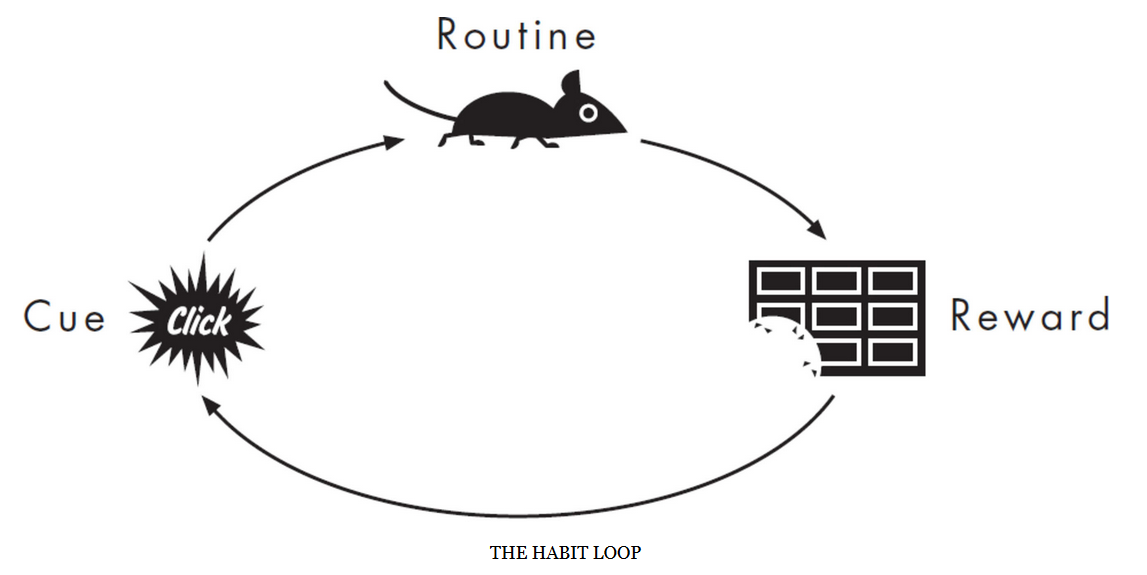
Most studies and authors agree that in order to form a habit, a person needs to repeat the so-called "habit cycle" many times, which consists of 3 key aspects: Trigger - Action - Reward .
Some bad person suggested that it is enough to repeat a similar cycle for 21 days to form habits, but traditional research repeatedly emphasizes that there is NO specific time period, since everything depends on the spheres of activity, human characteristics, contexts and 100,500 thousand other factors ...
For example, in his study on the effect of "random" rewardsWendy Wood and David Neal indicate that for some types of activities and people 18 days are enough, while some activities require repetition for 200+ days.
The main one: Habits are successfully formed by regularly going through the habit cycle, which consists of a trigger, an action and a reward.
BJ Fogg's Behavioral Model
The idea of the habit cycle is perfectly complemented / expanded by the model of Stanford professor BJ Fogg, which was also adapted by Nir Eyal in his bestseller, which every game designer “Hooked” should read (in Russian translation “On the Hook”).

According to this model, any behavior consists of a combination of three factors: motivation to do something, (physical) ability and trigger. Everything here is intuitive: the more complex the action, the higher the motivation should be in order to regularly perform it.
Obviously, learning English (like any other language, including programming languages) is more complex than, for example, using dental floss after brushing your teeth or drinking an extra half liter of water a day. Therefore, developing the habit of exercising every day requires a higher motivation to repeat successfully from time to time until the number of "habit cycles" reaches a critical level.
Special attention should be paid to the key types of triggers, since they are the starting point for the formation of any habit .
Key trigger types
In their monumental work on habits , which has collected 1,193 citations at the time of publication, the authors distinguish two main types of triggers: direct and motivated.
- Direct triggers are interactions between a context and a response to that context. Habits are formed by multiple co-activation of both elements.
If, sitting in the car (context), you regularly activate the reaction associated with the need to buckle up, a relationship is gradually formed between the context and the reaction, which is modified into a habit. Thus, after a certain time ( no, not after 21 days ) getting into the car leads to automatic fastening without having to think about it.
- Motivating triggers lead to a reward when performing a reaction (eating submissive) associated with a specific context (being in the cinema)
It is with this type of triggers that most game designers and marketers tend to interact. It is believed that with repeated activation of the “habit cycle” associated with motivating triggers, human behavior eventually becomes automatic and does not require further “motivation” to perform the habit. That is, triggers move from the category of motivating to direct.
However, in most cases, the use of such triggers is only of a short-term nature, as a result of which people roll back to their initial state (or even worse), before reaching the stage of the formed habit.
This effect can be seen in the graph from an excellent article by Wendy Wood and David Neal, in which they collected several examples from previous research.
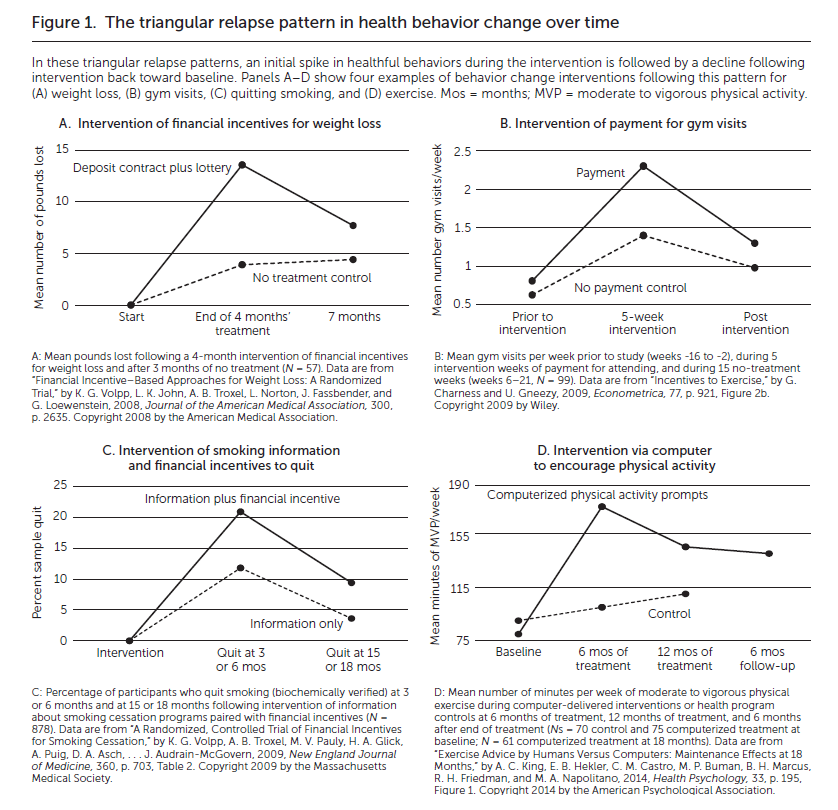
Many, probably, have at least once heard the stories of guys who managed to lose weight during short-term training / diets, but gain even more weight after the end of the program.
It is for this reason that many researchers, including the above guys, are suggesting a shift in focus to “ random rewards ” that show more consistent results.
So, for example, in a study with Chicago students, the guys were tasked with drinking 2 liters of water for 2 minutes for a fixed reward of $ 2 or a random reward of $ 1 or $ 2 by tossing a coin. The group with the random reward completed the task 73% of the time versus 40% in the group with the fixed bonus.
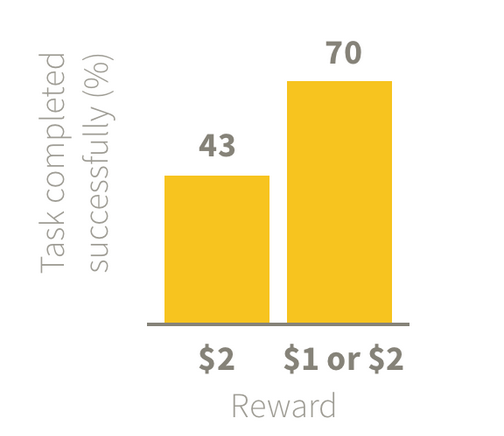
If you are into game design or "gamification", I highly recommend checking out Fishbach & Hsee's full study of The Motivating-Uncertainty Effect in which the authors conducted a series of interesting experiments demonstrating the power of this concept.
In addition to researchers, this idea is widely practiced by all kinds of game designers, which are expressed as special events (for example, every Wednesday at Heartstone, the Tavern Brawl is held, in which the usual game mechanics are completely changed), various Easter eggs and random gifts.
But let's get back to triggers. In addition to the subdivision into direct and motivating, in the literature there is often a division by type of context. There are 4 key types to consider here:
1. Triggers associated with time.
One of the easiest ways to start a new habit is to set aside some time for it.
Morning exercise, afternoon meditation, evening book reading are all examples of time-related habits.
2. Triggers related to location / environment
The environment plays a huge role in shaping our habits. It is enough to remove sweets with cookies from a prominent place on the table in a tall drawer - and the consumption of sweets is likely to decrease.
Thorndike and Sonnenberg conducted a study that reduced the number of soda sales and increased bottled water by increasing the number and visibility of areas where water was sold, as well as stickers that emphasize healthy and NOT healthy choices:
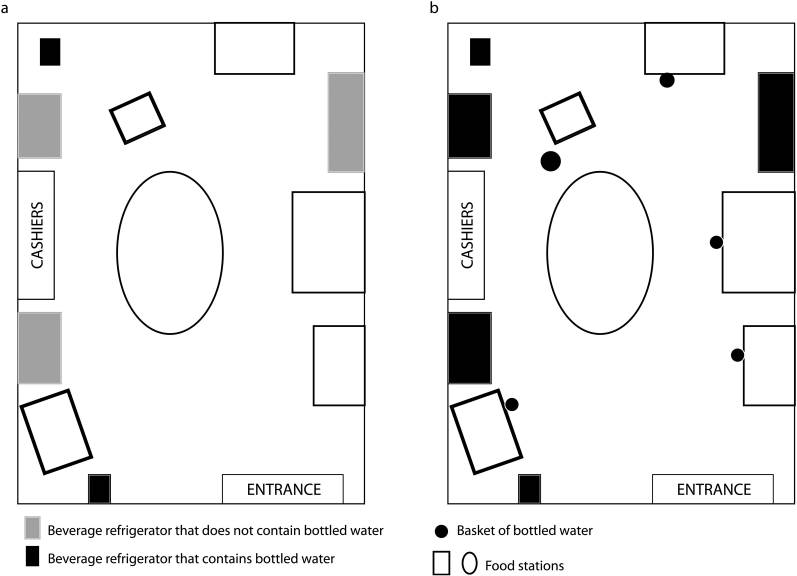
In the home, a good example of a trigger associated with location, there will be similar stickers on the refrigerator:

In addition to using a similar principle to get rid of negative habits, you can simplify the process of forming useful ones by arranging and dividing certain zones for work / study / rest; location of post-it stickers on the monitor with reminders to start classes at a certain time (using the time trigger), etc., etc.
You can read more about the principles of "harnessing" this type of triggers in the book "Atomic Habits" by James Clear.
3. Triggers associated with the antecedent event
In the literature, this type of trigger is most often called Habbit stacking or Piggybacking. His idea is that often attaching to an existing one can become a new habit.
For example, Judah, Gardner, and Aunger have shown that the likelihood of people using dental floss is significantly increased if a person uses it immediately after brushing (rather than BEFORE). That is, when we have an established habit of brushing our teeth, it is much easier to attach a new habit to it, rather than starting from scratch.
4. Triggers associated with people around
Or one of the reasons why Alcoholics Anonymous clubs and all sorts of weight loss reality shows work. Going out for a daily run is easier if you are in the company of a friend / spouse / like-minded person (especially if he has established himself as a runner).
In addition to everything in this approach, additional social responsibility plays a significant role, which is also important.
Negative habits often arise from this same trigger. For example, it is much more difficult for a teenager to cope with the temptation of bad habits by getting into a “bad” company. That is why your mother preferred that you communicate more with the excellent student Misha, and not slobber Vasya.
Implementation intentions - implementation / implementation intentions.
Understanding the basic trigger types is great, but to go even further, you can add implementation intents here.
Numerous studies support the idea that a clear “declaration of intent to implement an action” has a positive impact on outcome. Moreover, such intentions are especially effective in situations where a person can associate several types of triggers in one declaration.
A person who is able to agree “with himself” that he will study English every day from 19:00 to 19:30 in his office has a much higher chance of success. He not only clearly states the intention, but also associates the action with two types of triggers: time (19:00 to 19:30) and location (his office)
This practice gives great results with one caveat: THE PERSON SHOULD HAVE A PURPOSE TO LEARN THE LANGUAGE.
For example, in a study from Sheeran, Webb, and Gollwitzer “The Interplay Between Goal Intentions and Implementation Intentions,” the authors concluded that students who declared their intentions to study independently in a certain place at a certain time were more likely to realize intentions (than those who who did not abandon the intention), but only if the student clearly noted for himself the importance of studying in general.
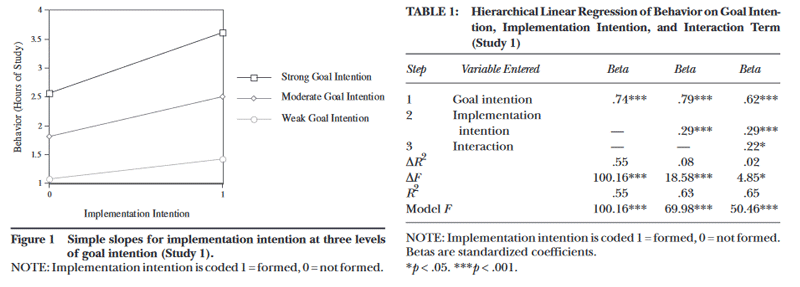
* pay attention to the difference in the angle of inclination of the straight lines in people with a high level of "importance of learning" and low.
That is why, in addition to learning English, we conduct regular workshops for our students on the possibilities of free education in the USA or Europe, immigration and travel hacks, which help to save a lot of money thanks to the knowledge of English.
Practical examples of intentions implementation
According to this theory, such a declaration significantly increases the chances of “fixing the habit”. English lessons can be replaced with the habit you need:
Time:
"I will study English from 19 to 19:30 every day"
Place:
"I will study English in my office / minibus / metro / tram / traffic jam"
Previous event:
"I will study English after morning meditation / coming home / press review / reading a book / gym / brushing teeth, etc., etc."
People:
"I will sign up for the same English courses where Zhorik goes (by the way, my active classes. Thank you, Zhorik) "
And all sorts of combinations like:
" I will study English every day from 19 to 19 30 in my office with Zhorik . "
And for dessert: Ikea effect, Sunk Cost effect and Zeigarnik effect.
These three simple, but non-obvious effects made a huge contribution to the formation of the habit of studying among students of our English course:

As a person who a month ago assembled 3 ikeevsky tables, 6 chairs, a sofa, a bed and a bunch of little things like TV stands and cabinets, I have Doubts began to arise about the Ikea effect , which implies that people value more the things that they have made an effort to achieve.
It is well complemented by the effect known in the Sunk Cost economy , due to which my parents still cannot part with their supermarket in Crimea, despite the fact that after certain events in 2014, its profitability dropped significantly. Sunk Cost literally translated from English - drowned funds.
In the classic case, this effect is used in microeconomics and consulting. As my professor used to say: When making a decision to close a business, IN NO EVENT should one take into account the invested funds. They have already DROWNED. Only the current situation matters.
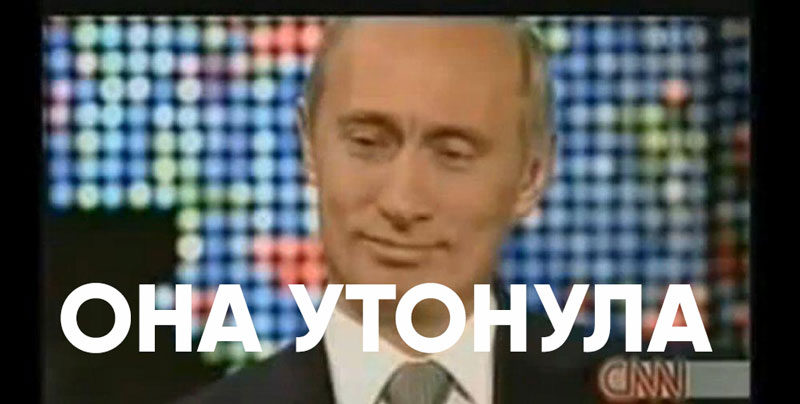
Nevertheless, a huge number of entrepreneurs like my parents continue to invest in knowingly unprofitable enterprises. People are not inclined to "leave" businesses or any occupation in which significant mental effort or material costs have been applied.
This same property is widely used in all kinds of startups. The more time you spend learning Spotify and putting together all sorts of playlists, the less likely you are to abandon the service.
Using this phenomenon during habit formation helps to significantly increase the chances of successful “fixation”. In a couple of moments, I will show with specific examples how we use this technique in learning English.
But before starting to practice, let me say a few words about the effect, which is widely popular in the West, and is practically forgotten in our country, despite the fact that the Soviet scientist Bluma Wolfovna Zeigarnik is considered its "discoverer".
In short: the Zeigarnik effect says that unfinished tasks are much more "sticky" in our brain than completed ones.
At one time, I very well felt the influence of this effect in life, following the advice of a math teacher, who urged me to carefully read the condition of ALL tasks in the exam before starting the solution. Thanks to this, the brain begins to "process" tasks in the background and leads to an accelerated solution in general.
For the same reason, many psychologists recommend changing the picture in case of "freezing" on a specific task, because a change in focus stimulates the brain to solve a problem "hung" in the RAM.
How we put the theory into practice and the results were crazy.
Disclaimer : Each of the following changes was introduced into the training process iteratively, without taking precise measurements at certain steps. However, after implementing ALL of the following techniques, I conducted a small A / B test in which 200 people took part (100 according to the old program and 100 according to the new one).
As I wrote above, on average, the percentage of completed daily tasks on time increased from 38 to 89%, which significantly reduced the percentage of students who dropped out of the course. 9 out of 10 children successfully complete all 3 months of training (versus 6 out of 10 before the course structure was changed).
Below are the changes in group B that affected the result:
1. During the first week of class, students receive a summary of the above material that highlights the importance of daily assignments and provides examples of how time / place / prior events and people “triggers” are used to form habits.
For example, for completing tasks in a time period selected by the user, bonus points are awarded (time trigger). There is an opportunity to add a friend to classes for 1000 rubles per month (trigger of people).
2. Once a week, students record a short selfie video based on the materials of the previous week, with examples of which you can find on our landing page by the link . These videos perform 2 tasks: First, they are a kind of starting point and

indicator of progress . Learning languages is a rather lengthy process and the ability to visually track the development of skills is an excellent perk, which is especially important for complete beginners (it is this group that most often abandons classes due to "lack of results" in the shortest possible time).
Secondly, such tasks activate Ikea and Sunk Cost effects, encouraging users to "invest" additional emotional costs in the learning process.
3. Speaking about Ikea and Sunk Cost effects, it is worth adding that students who create cards with unfamiliar words with their own hands not only receive incentive discounts of 1000 rublesfor each subsequent month of classes, but also significantly increase the effectiveness of memorizing these very words.
You can read more about cards in one of the previous articles on Habré or look at the example picture below:

4. Every morning at 9:00 local time (time trigger), students receive a short video assignment from one of the Americans who is trying to explain the hidden word :
The student should a) try to guess what word is being spoken about and b) try to record the speech he heard in as much detail as possible.
Speakers are constantly changing (to avoid getting used to a certain accent) and use exclusively colloquial vocabulary, which is why many guys have difficulties (especially those who have never studied English). Therefore, after 7 hours, the user receives a hint with a proposal to improve his original version. Something like that:
_ people _ _ you. Usually _ opposite _. But nowadays _ _ seeing _ lot, you _, _. _, nevertheless, they _ _ people you _ _ to _ throughout _ life _ they _ _
The Zeigarnik effect allows you to return to an unfinished assignment and listen to the video several more times during the assignment. And this is critically important, because listening is one of the most difficult areas in mastering any language, and each additional listening plays a huge role in the successful acquisition of a skill.

5. After a protracted failed experiment with flying gamification and dozens of prizes (from top-ups, to surprise gift boxes from the USA and iPhones), which I will talk about another time, we once again made sure that randomsmall gifts like postcards with happy wishes from the States, small favors like Lego sets with statues of liberty and unplanned calls with carriers are a much stronger "motivator" than planned pranks, which the CIS has long lost confidence in.
At the same time, in order to be able to win a prize, it is enough just to complete the task on time.

This practice helps to significantly smooth the corners of all kinds of "tournament" draws, where gifts are given to the best, and equally stimulates students of absolutely all levels of training. It is enough just to complete tasks on time.
6. Remembering the problem of "slow progress", the student receives weekly personalized statistics, which not only reflects his progress, but also problem areas that should be paid attention to next week.
By the way, progress bars themselves to reflect progress are an excellent example of the Goal-Gradient effect, described back in 1932 by psychologist Clark Hull. Unfortunately, I could not find a suitable definition in the Russian-language literature, but suddenly you want to learn the CORRECT use of progress bars, pay attention to 1 , 2 , 3 , 4 , 5 .
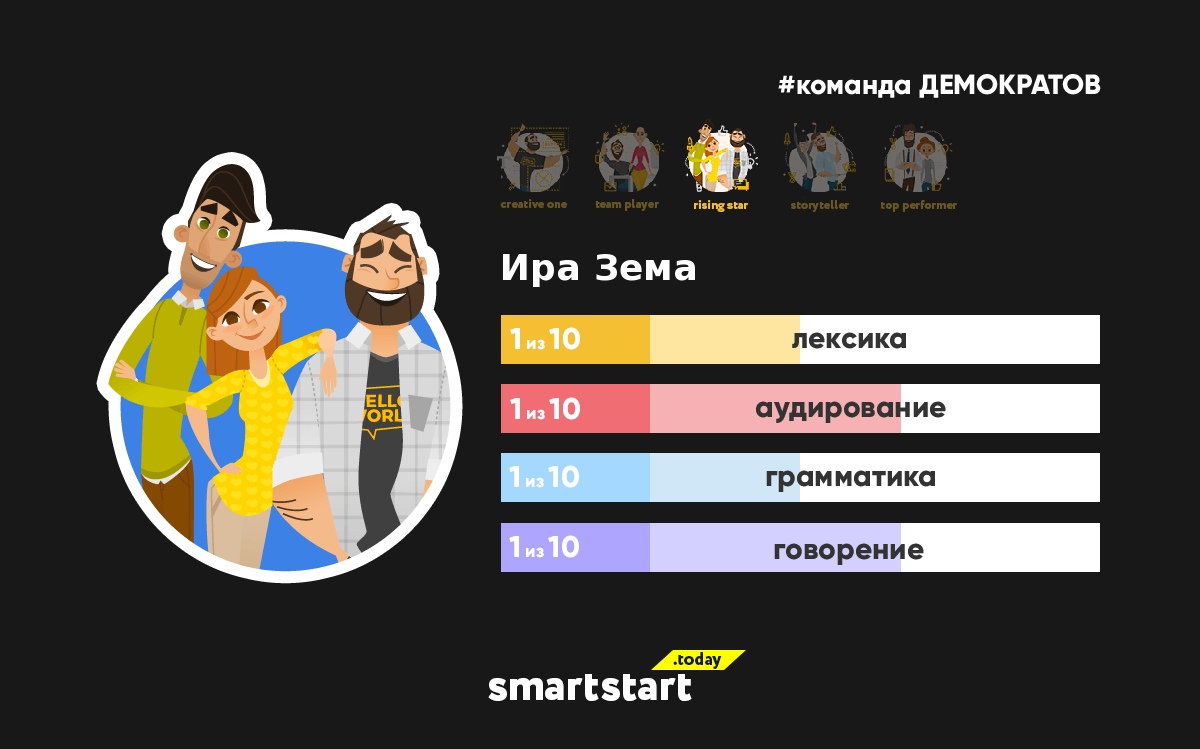
And if you want not only to feel the system for yourself, but also to tighten up your English,join our marathon or try a demo week for 250 rubles: smartstart.today/english-special
In the next article I will tell you why we use a paid, not a free demo period and, perhaps, I can dispel a few misconceptions about freemium models in general with using scientific articles and practical observations.
TLDR: Successful habit formation is associated with repeatedly performing a “habit cycle” of trigger, action, and reward (and has nothing to do with 21 days). The simplest and most effective triggers include time, place, previous events, and people. Spontaneous / random rewards are often more effective than those known in advance, and clearly stated implementation intentions have an extremely positive effect on habit formation, provided there is a clear goal. It is important to note that achieving a goal is a “strategy” with many variations of actions, while habit rather plays a “tactical” role with a lack of variability and a banal repetition of the same type of sequence.